-
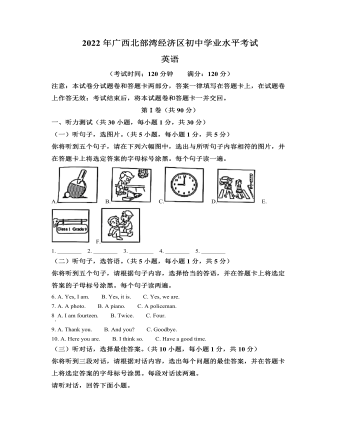
2022年广西北部湾经济区中考英语真题(解析版)
Ibelieved that I was right and he was wrong, and Tony believed that I was wrongand he was right. Our teacher, a kind and smart lady, decided to teach us alesson. She brought us to the front of the class and placed him on one side ofher desk and me on the other. In the middle of her desk was a large and roundobject. I could clearly see that it was black. The teacher asked us what colorthe object was. “White,” Tony answered. I couldn’t believe he said the objectwas white! “Clearly, it was black!” Another argument started between Tony andme, this time about the color of the object.
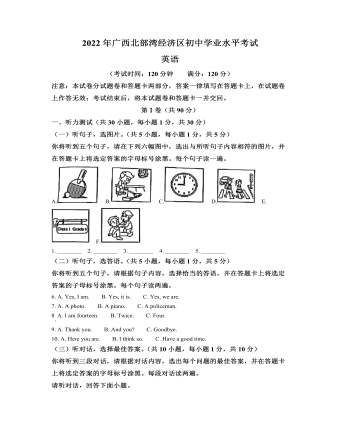
2022年广西北部湾经济区中考英语真题(解析版)
Ibelieved that I was right and he was wrong, and Tony believed that I was wrongand he was right. Our teacher, a kind and smart lady, decided to teach us alesson. She brought us to the front of the class and placed him on one side ofher desk and me on the other. In the middle of her desk was a large and roundobject. I could clearly see that it was black. The teacher asked us what colorthe object was. “White,” Tony answered. I couldn’t believe he said the objectwas white! “Clearly, it was black!” Another argument started between Tony andme, this time about the color of the object.

2022年广西北部湾经济区中考英语真题(原卷版)
By usingthis method, the study found that red meats were the most unfriendly foods tothe environment. Keeping farm animals produces a large number of methane(甲烷)that keeps 30 times more heat than CO2. As well asmaking the earth warmer, eating too much red meat is known to increase the riskof a few illnesses, such as heart trouble.
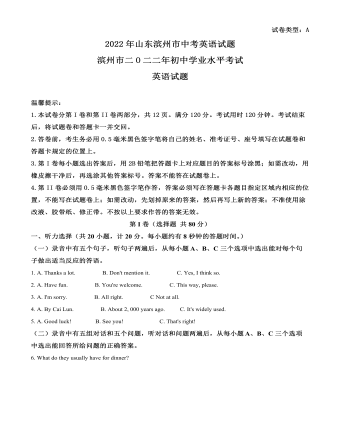
2022年山东省滨州市中考英语真题(解析版)
Everyone knows how similar chimpanzees (黑猩猩)are to humans. So it’s no surprise that their greetings are also close to ours.The most common ways of greeting between chimpanzees are hand touching andhugging. Sometimes they also kiss each other. Some chimpanzees can even learnsimple sign language.
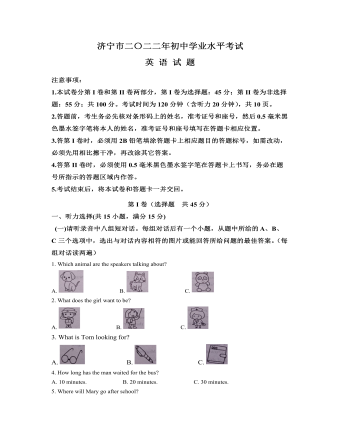
2022年山东省济宁市中考英语真题(原卷版)
Each ofthem has their own experience- two people with synesthesia may both “feel”music, but they almost never feel the music in the same way. For example, onemay feel the music of the violin lightly brushing his face; the other may feelit on her ankle (脚踝). And one’s experience of synesthesia is alwaysthe same. If they see the number 5 in the color blue, then 5 is blue every timethey see it.

2022年山东省滨州市中考英语真题(原卷版)
As thegovernment encourages the renaissance (复兴) of traditional culture,Hanfu is getting more and more popular with the teenagers. Every year, we canenjoy different Hanfu shows around the cities. And now quite a few Hanfu clubshave been set up in universities. Members usually wear Hanfu at theirgraduation ceremonies or during holidays. Some even wear Hanfu on regular days,too. And these fans created a special day—China Haniu Day to celebratetraditional Chinese clothing. It falls on the third day of the third month inChinese lunar calendar (阴历).
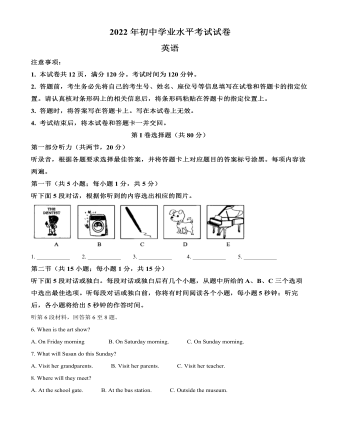
2022年内蒙古包头市中考英语真题(解析版)
Mostschools offer different kinds of subjects and activities for students, but someschools offer additional training in certain areas, such as the performing andarts. In this way, schools can help students develop their artistic talentsfrom an early age and have greater success in their future profession. THE ROYAL BALLET(芭蕾舞)SCHOOL
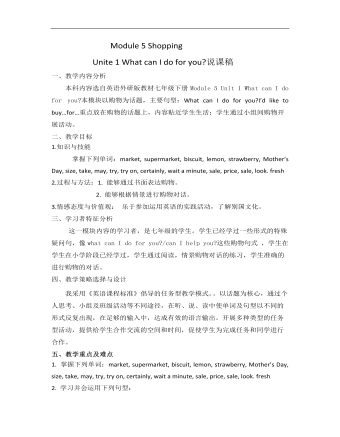
初中英语外研版七年级下册《Module 5 Shopping》说课稿
二、教学目标1.知识与技能掌握下列单词:market, supermarket,biscuit, lemon, strawberry, Mother’s Day, size, take, may, try, try on,certainly, wait a minute, sale, price, sale, look. fresh2.过程与方法:1. 能够通过书面表达购物。2. 能够根据情景进行购物对话。3.情感态度与价值观:乐于参加运用英语的实践活动,了解别国文化。
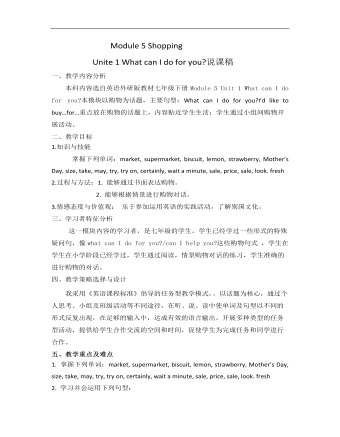
初中英语外研版七年级下册《Module 5 Shopping》说课稿
二、教学目标1.知识与技能掌握下列单词:market, supermarket,biscuit, lemon, strawberry, Mother’s Day, size, take, may, try, try on,certainly, wait a minute, sale, price, sale, look. fresh2.过程与方法:1. 能够通过书面表达购物。2. 能够根据情景进行购物对话。3.情感态度与价值观:乐于参加运用英语的实践活动,了解别国文化。三、学习者特征分析这一模块内容的学习者,是七年级的学生。学生已经学过一些形式的特殊疑问句,像what can I do for you?/can I help you?这些购物句式 ,学生在学生在小学阶段已经学过,学生通过阅读,情景购物对话的练习,学生准确的进行购物的对话。
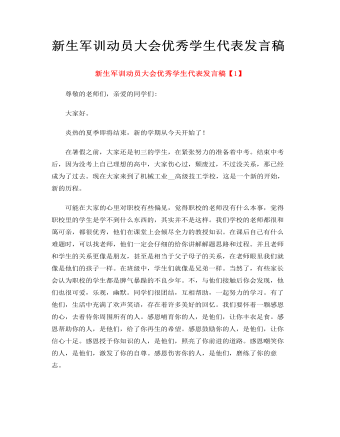
新生军训动员大会优秀学生代表发言稿
我是___班的___。今天,我非常荣幸够代表全体新生在开学典礼上发言。昨天我们带着父母的叮咛,师长的关切,满怀好奇和憧憬,带着依然稚嫩的笑脸走进了校园。作为新生,我们在感受着这新鲜的同时,也更快的融入了这个温暖而富有亲和力的大家庭中。从踏进学校的那一刻起,所有的疲倦和迷茫,都被抛之脑后,所有离家的顾虑全部一扫而光。老师们的亲切关怀,同学们的热情帮助,都暖暖地包容着我们。请允许我借此机会,向老师及同学们表示最崇高的敬意和感谢! 同学们,我们来到学校都应该给自己树立一个的目标,我认为无论树立的是什么目标,做一名优秀的学生是最基本的。当你早上背着书包迎着朝阳开始一天的学习时,要抬头挺胸,精神振作,信心百倍,你的心里要装上一个伟大的决心;当你在放学回家的路上,你要摸摸自己的书包,问问自己今天你又学到了什么?有没有白白浪费一天的光阴,距离伟大的理想、美好的愿望是不是又近了一步?

关于小学教师个人教学心得体会优选八篇
作为一一名任课教师,我们或许都有过这样的体验,每当上完一节好课,会让你有意犹未尽之感,全身都会感到舒爽之至。而往往公开课更容易达到这样的境界。想想为什么,一个很重要的原因就是我们无形中做到了“懂”、“透”、“化”。 总之,我们在处理教材上真正做到“懂”、“透”、“化”,真正做到“钻进去,走出来”,就会达到创设教材研究的理想境界。
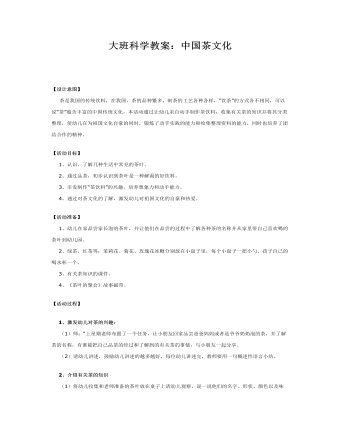
大班科学教案:中国茶文化
【活动目标】 1、认识,了解几种生活中常见的茶叶。 2、通过品茶,初步认识到茶叶是一种解渴的好饮料。 3、引发制作“茶饮料”的兴趣,培养想象力和动手能力。 4、通过对茶文化的了解,激发幼儿对祖国文化的自豪和热爱。【活动准备】 1、幼儿在家品尝家长泡的茶叶,并让他们在品尝的过程中了解各种茶的名称并从家里带自己喜欢喝的茶叶到幼儿园。 2、绿茶、红茶等:茉莉花、菊花、玫瑰花冰糖分别放在小盘子里,每个小盘子一把小勺、孩子自己的喝水杯一个。 3、有关茶知识的课件。 4、《茶叶的聚会》故事磁带。【活动过程】 1、激发幼儿对茶的兴趣: (1)师:“上星期老师布置了一个任务,让小朋友回家品尝爸爸妈妈或者是爷爷奶奶泡的茶,并了解茶的名称,有谁能把自己品茶的经过和了解到的有关茶的事情,与小朋友一起分享。 (2)请幼儿讲述,鼓励幼儿讲述的越多越好,每位幼儿讲述完,教师要用一句概述性语言小结。
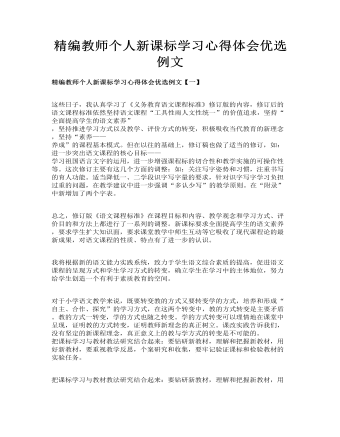
精编教师个人新课标学习心得体会优选例文
我将根据新的语文能力实践系统,致力于学生语文综合素质的提高,促进语文课程的呈现方式和学生学习方式的转变,确立学生在学习中的主体地位,努力给学生创造一个有利于素质教育的空间。 对于小学语文教学来说,既要转变教的方式又要转变学的方式,培养和形成“自主、合作、探究”的学习方式,在这两个转变中,教的方式转变是主要矛盾。教的方式一转变,学的方式也随之转变。学的方式转变可以理情地在课堂中呈现,证明教的方式转变,证明教师新理念的真正树立。课改实践告诉我们,没有坚定的新课程理念,真正意义上的教与学方式的转变是不可能的。把课标学习与教材教法研究结合起来:要钻研新教材,理解和把握新教材,用好新教材,要重视教学反思,个案研究和收集,要牢记验证课标和检验教材的实验任务。
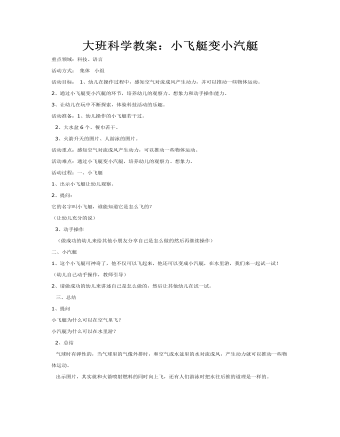
大班科学教案:小飞艇变小汽艇
2、通过小飞艇变小汽艇的环节,培养幼儿的观察力、想象力和动手操作能力。 3、让幼儿在玩中不断探索,体验科技活动的乐趣。 活动准备:1、幼儿操作的小飞艇若干过。 2、大水盆6个、餐巾若干。 3、火箭升天的图片、人游泳的图片。 活动重点:感知空气对流成风产生动力,可以推动一些物体运动。 活动难点:通过小飞艇变小汽艇,培养幼儿的观察力、想象力。 活动过程:一、小飞艇 1、出示小飞艇让幼儿观察。 2、提问: 它的名字叫小飞艇,谁能知道它是怎么飞的? (让幼儿充分的说) 3、动手操作 (做成功的幼儿来给其他小朋友分享自己是怎么做的然后再继续操作)
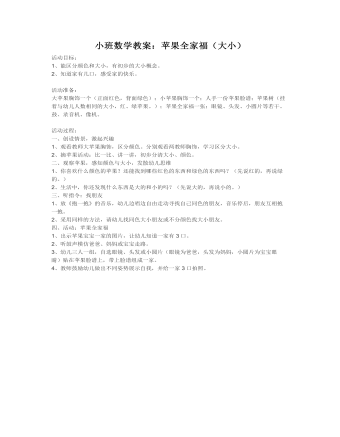
小班数学教案:苹果全家福(大小)
2、知道家有几口,感受家的快乐。 活动准备: 大苹果胸饰一个(正面红色,背面绿色);小苹果胸饰一个;人手一份苹果脸谱;苹果树(挂着与幼儿人数相同的大小,红、绿苹果。);苹果全家福一张;眼镜、头发、小圆片等若干。鼓、录音机、像机。 活动过程: 一、创设情景,激起兴趣 1、观看教师大苹果胸饰,区分颜色。分别观看两教师胸饰,学习区分大小。 2、摘苹果活动:比一比、讲一讲,初步分清大小、颜色。
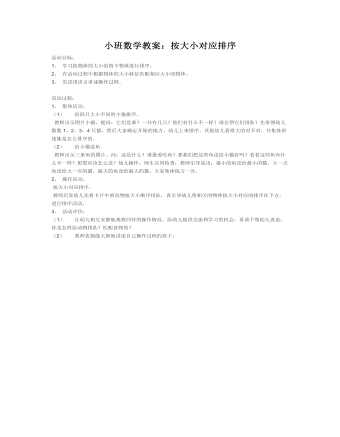
小班数学教案:按大小对应排序
2、 在活动过程中根据物体的大小特征匹配相应大小的物体。3、 尝试用语言讲述操作过程。活动过程:1、 集体活动。 (1) 给四只大小不同的小猫排序。 教师出示图片小猫,提问:它们是谁?一共有几只?他们有什么不一样?谁会帮它们排队?先带领幼儿数数1、2、3、4只猫,然后大家确定开始的地方,幼儿上来排序,其他幼儿看排大的对不对,并集体讲述她是怎么排序的。(2) 给小猫送鱼。 教师出示三条鱼的图片。问:这是什么?谁最爱吃鱼?那我们把这些鱼送给小猫好吗?看看这些鱼有什么不一样?想想应该怎么送?幼儿操作,师生共同检查,教师引导说出:最小的鱼送给最小的猫,大一点鱼送给大一点的猫,最大的鱼送给最大的猫。大家集体练习一次。
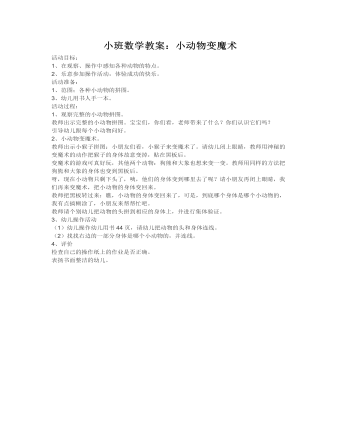
小班数学教案:小动物变魔术
2、乐意参加操作活动,体验成功的快乐。 活动准备: 1、范图;各种小动物的拼图。 3、幼儿用书人手一本。 活动过程: 1、观察完整的小动物拼图。 教师出示完整的小动物拼图。宝宝们,你们看,老师带来了什么?你们认识它们吗? 引导幼儿跟每个小动物问好。
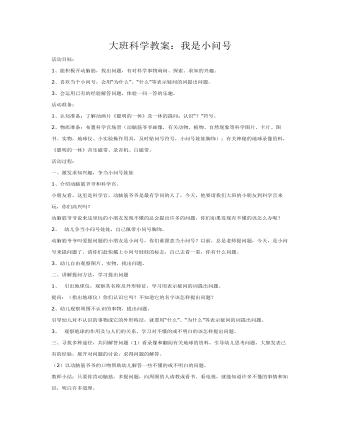
大班科学教案:我是小问号
3、会运用已有的经验解答问题,体验一问一答的乐趣。活动准备:1、认知准备:了解动画片《聪明的一休》及一休的提问;认识“?”符号。2、物质准备:布置科学宫场景(动脑筋爷爷画像,有关动物、植物、自然现象等科学图片、卡片、图书、实物,地球仪、小实验操作用具,及时贴问号符号,小问号娃娃胸饰);有关神秘的地球录像资料,《聪明的一休》音乐磁带、录音机、白磁带。活动过程:一、激发求知兴趣,争当小问号娃娃1、介绍动脑筋爷爷和科学宫。小朋友看,这里是科学官,动脑筋爷爷是最有学问的人了,今天,他要请我们大班的小朋友到科学宫来玩,你们高兴吗?动脑筋爷爷说来这里玩的小朋友发现不懂的总会提出许多的问题,你们如果发现有不懂的该怎么办呢?2、 幼儿争当小问号娃娃,自己佩带小问号胸饰。动脑筋爷爷叫爱提问题的小朋友是小问号,你们谁愿意当小问号?以前,总是老师提问题,今天,是小问号来提问题了。请你们赶快戴上小问号娃娃的标志,自己去看一看,你有什么问题。
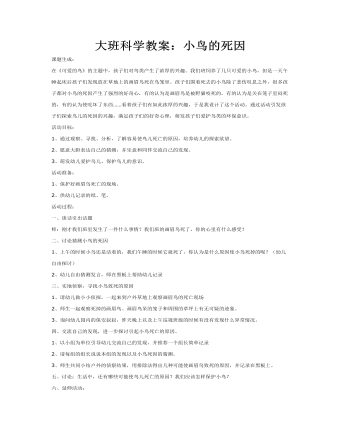
大班科学教案:小鸟的死因
活动目标: 1、通过观察、寻找、分析,了解容易使鸟儿死亡的原因,培养幼儿的探索欲望。 2、愿意大胆表达自己的猜测,并乐意和同伴交流自己的发现。 3、萌发幼儿爱护鸟儿、保护鸟儿的意识。 活动准备: 1、保护好画眉鸟死亡的现场。 2、供幼儿记录的纸、笔。 活动过程: 一、谈话引出话题 师:刚才我们班里发生了一件什么事情?我们班的画眉鸟死了,你的心里有什么感受? 二、讨论猜测小鸟的死因 1、上午的时候小鸟还是活着的,我们午睡的时候它就死了,你认为是什么原因使小鸟死掉的呢?(幼儿自由探讨) 2、幼儿自由猜测发言,师在黑板上帮助幼儿记录
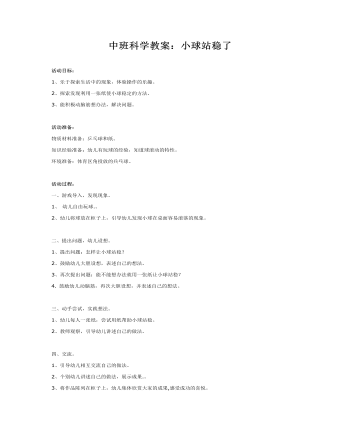
中班科学教案:小球站稳了
2、探索发现利用一张纸使小球稳定的方法。3、能积极动脑筋想办法,解决问题。 活动准备:物质材料准备:乒乓球和纸。知识经验准备:幼儿有玩球的经验,知道球滚动的特性。环境准备:体育区角投放的兵乓球。

